戴炜栋《新编简明英语语言学教程》笔记和课后习题(含考研真题)详解-第6~8章【圣才出品】
- 格式:pdf
- 大小:1.73 MB
- 文档页数:121
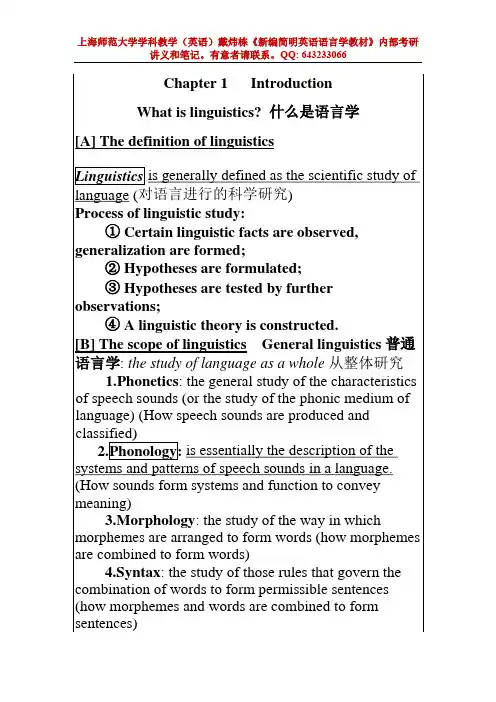
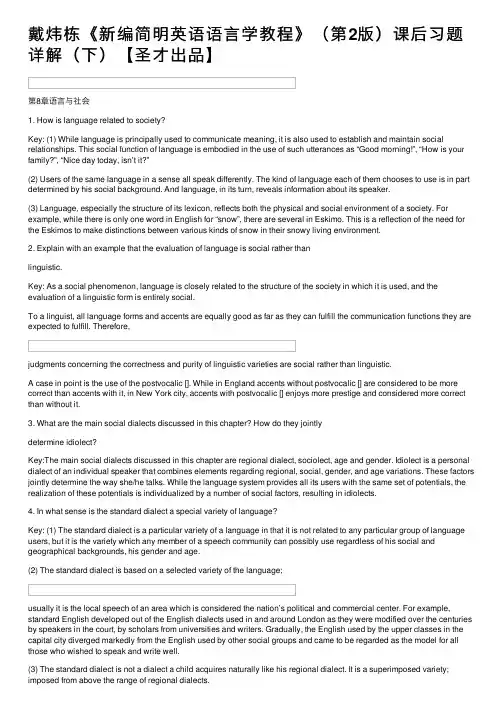
戴炜栋《新编简明英语语⾔学教程》(第2版)课后习题详解(下)【圣才出品】第8章语⾔与社会1. How is language related to society?Key: (1) While language is principally used to communicate meaning, it is also used to establish and maintain social relationships. This social function of language is embodied in the use of such utterances as “Good morning!”, “How is your family?”, “Nice day today, isn’t it?”(2) Users of the same language in a sense all speak differently. The kind of language each of them chooses to use is in part determined by his social background. And language, in its turn, reveals information about its speaker.(3) Language, especially the structure of its lexicon, reflects both the physical and social environment of a society. For example, while there is only one word in English for “snow”, there are several in Eskimo. This is a reflection of the need for the Eskimos to make distinctions between various kinds of snow in their snowy living environment.2. Explain with an example that the evaluation of language is social rather thanlinguistic.Key: As a social phenomenon, language is closely related to the structure of the society in which it is used, and the evaluation of a linguistic form is entirely social.To a linguist, all language forms and accents are equally good as far as they can fulfill the communication functions they are expected to fulfill. Therefore,judgments concerning the correctness and purity of linguistic varieties are social rather than linguistic.A case in point is the use of the postvocalic []. While in England accents without postvocalic [] are considered to be more correct than accents with it, in New York city, accents with postvocalic [] enjoys more prestige and considered more correct than without it.3. What are the main social dialects discussed in this chapter? How do they jointlydetermine idiolect?Key:The main social dialects discussed in this chapter are regional dialect, sociolect, age and gender. Idiolect is a personal dialect of an individual speaker that combines elements regarding regional, social, gender, and age variations. These factors jointly determine the way she/he talks. While the language system provides all its users with the same set of potentials, the realization of these potentials is individualized by a number of social factors, resulting in idiolects.4. In what sense is the standard dialect a special variety of language?Key: (1) The standard dialect is a particular variety of a language in that it is not related to any particular group of language users, but it is the variety which any member of a speech community can possibly use regardless of his social and geographical backgrounds, his gender and age.(2) The standard dialect is based on a selected variety of the language;usually it is the local speech of an area which is considered the nation’s political and commercial center. For example, standard English developed out of the English dialects used in and around London as they were modified over the centuries by speakers in the court, by scholars from universities and writers. Gradually, the English used by the upper classes in the capital city diverged markedly from the English used by other social groups and came to be regarded as the model for all those who wished to speak and write well.(3) The standard dialect is not a dialect a child acquires naturally like his regional dialect. It is a superimposed variety; imposed from above the range of regional dialects.(4) The standard dialect has some special functions. Also designated as the official or national language of a country, the standard dialect is used for such official purpose as government documents, education, news reporting; it is the language used on any formal occasions.5. What is register as used by Halliday? Illustrate it with an example of your own. Key: According to Halliday, “Language varies as its function varies; it differs in different situations.” The type of language which is selected as appropriate to the type of situation is a register. Halliday further distinguishes three social variables that determine the register: field of discourse, tenor of discourse, and mode of discourse.For example, a lecture on biology in a technical college could be identifiedas:Field: scientific (biological)Tenor: teacher-students (formal, polite)Mode: oral (academic lecturing)6. What linguistic features of Black English do you know? Do you think Black English is an illogical and inferior variety of English? Why (not)?Key: (1) Linguistic features of Black English:Phonological features: simplification of consonant clusters at the end of a word. According to this consonant deletion rule, the final-position consonants are often deleted; thus “passed” is often pronounced [], mend [], desk [], and told [].Syntactic features one: the deletion of link verb “be”. In Black English, we often come across many sentences without copula verb: “They mine”, “You crazy”, “Her hands cold”, and “That house big”. In fact, copula verb deletion is not a unique feature of Black English, it is often found in other dialects of English and in languages like Russian and Chinese.Syntactic features two: the use of double negation structure. e.g.He don’t know nothing. (He doesn’t know anything.)I ain’t afraid of no ghosts. (I am not afraid of ghosts.)Some people consider these sentences illogical because they claim that two negatives make positive. But in fact, such double negative constructions werefound in all dialects of English of earlier period.(2) I don’t think Black English is an illogical and inferior variety of English.Linguists are agreed that no variety of a language is inherently better than any other. They insist that all languages and all varieties of a particular language are equal in that they quite adequately serve the needs of those who use them. The only exception they recognize are pidgins, which are by definition restricted varieties, or the varieties we associate with people who are impaired in some way, e.g. certain mentally or physically handicapped people. American English is considered “better”only in a social sense: it has a preferred status; it gives those who use it certain social advantages; and it increases their life chances. Black English, being a nonstandard variety, tends to produce the opposite effect. These are some of the consequences that follow from elevating one variety and denigrating others, but there is no reason to suppose that any one of the varieties is intrinsically more worthy than any other.7. What peculiar features does pidgin have?Key: A pidgin is a special language variety that mixes or blends languages and it is used by people who speak different languages for restricted purposes such as trading. Pidgin arose from a blending of several languages such as Chinese dialects and English, African dialects and French. Usually a European language serves as the basis of the pidgin in the sense that some of its grammar and vocabulary is derived from the European language used by traders andmissionaries. Pidgins typically have a limited vocabulary and a reduced grammatical structure characterized by the loss ofinflection, gender and case. The “simplified” variety performs its function as trading and employment.8. How do bilingualism and diglossia differ, and what do they have in common? Key: Differences:(1)Bilingualism refers to the situation that two languages are used side by side with each having a different role to play; and language switching occurs when the situation changes.(2)Diglossia, refers to a sociolinguistic situation similar to bilingualism. In a diglossic situation, two varieties (high variety and low variety) of a language, instead of two different languages, exist side by side throughout the community, with each having a definite role to play. One of the most important features of diglossia is the specialization of function of the two varieties. Each variety is the appropriate language for certain situations with very slight overlappings.Similarity:The two languages of bilingualism and two varieties of diglossia exist side by side and have different role to play as situation changes.。

戴炜栋《新编简明英语语⾔学教程》笔记和课后习题(含考研真题)详解(⾳位学)【圣才出品】第2章⾳位学2.1 复习笔记本章要点:1. Speech Organs发⾳器官2. Distinction, Classification and the Criteria of Description between Constants and Vowels辅⾳和元⾳的区别、分类及描写规则3. Phonemes and Allophones⾳位和⾳位变体4. Phonological Rules and Distinctive Features⾳系规则和区别特征5. Syllable Structure, Stress and Intonation⾳节结构、重⾳和语调本章考点:1. 语⾳学语⾳学的定义;发⾳器官的英⽂名称;英语辅⾳的定义、发⾳部位、发⾳⽅法和分类;英语元⾳的定义和分类、基本元⾳;发⾳语⾳学;听觉语⾳学;声学语⾳学;语⾳标记,国际⾳标;严式与宽式标⾳法。
2. ⾳系学⾳系学的定义;⾳系学与语⾳学的联系和区别;⾳素、⾳位、⾳位变体、最⼩对⽴体、⾃由变体的定义;⾃由变体;⾳位的对⽴分布与互补分布;区别性特征;超语段⾳位学;⾳节;重⾳(词重⾳、句⼦重⾳);⾳⾼和语调。
本章内容索引:I. The phonic medium of languageII. Phonetics1. The definition of phonetics2. Three research fields3. Organs of speech▼4. Voiceless sounds▼5. Voiced sounds6. Orthographic representations of speech sounds—broad and narrow transcriptions7. Classification of English speech sounds(1) Definition(2) Classification of English consonants(3) Classification of English vowelsIII. Phonology1. Relationship between Phonology and phonetics2. Phone, phoneme3. Allophone4. Some rules in phonology(1) Sequential rules(2) Assimilation rule(3) Deletion rule5. Supra-segmental features—stress, tone, intonation(1) Stress(2) Tone(3) IntonationI. The phonic medium of language(语⾔的语⾳媒介)II. Phonetics(语⾳学)1. The definition of phonetics(语⾳学的定义)Phonetics is defined as the study of the phonic medium of language; it is concerned with all the sounds that occur in the world’s languages.语⾳学被定义为对语⾔的语⾳媒介的研究;它涉及所有出现在世界语⾔中的声⾳。
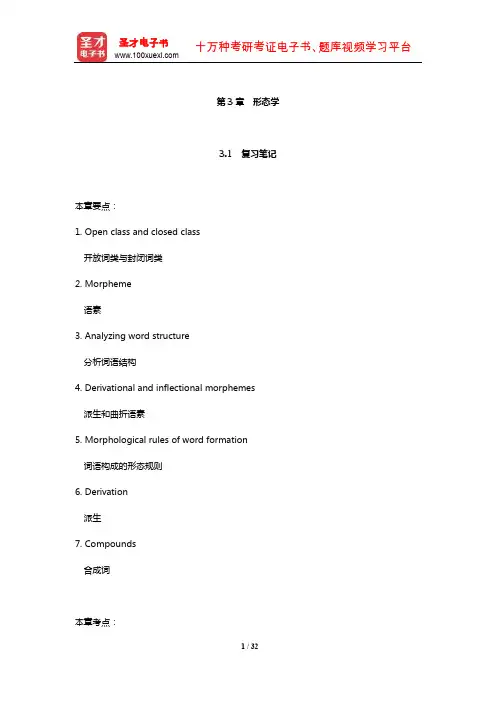
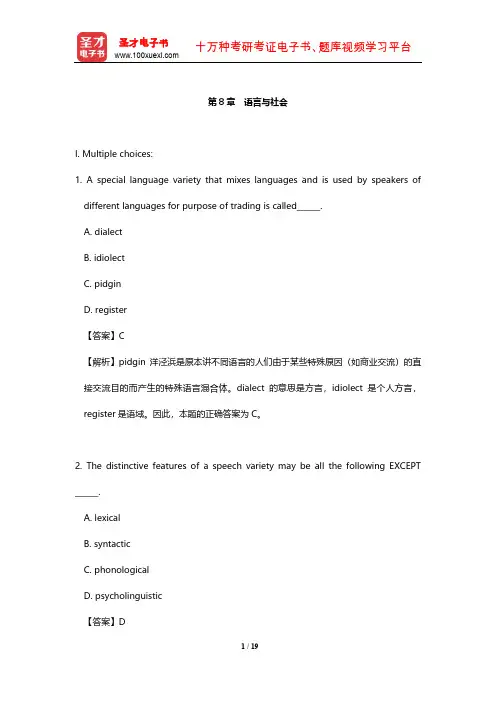
第8章语言与社会I. Multiple choices:1. A special language variety that mixes languages and is used by speakers of different languages for purpose of trading is called______.A. dialectB. idiolectC. pidginD. register【答案】C【解析】pidgin洋泾浜是原本讲不同语言的人们由于某些特殊原因(如商业交流)的直接交流目的而产生的特殊语言混合体。
dialect的意思是方言,idiolect是个人方言,register是语域。
因此,本题的正确答案为C。
2. The distinctive features of a speech variety may be all the following EXCEPT ______.A. lexicalB. syntacticC. phonologicalD. psycholinguistic【答案】D【解析】语言的变体可以是词法、句法、音位方面的变化。
心理语言学是语言学的一个分支。
因此,本题的正确答案为D。
3. Which of the following is NOT the speech variety?A. Regional dialects.B. Sociolects.C. Registers.D. Discourse accents.【答案】D【解析】在社会语言学的研究中,人们对三种言语变体特别感兴趣,即:地域方言、社会方言和语域。
因此,本题的正确答案为D。
4. Which of the following does NOT fall into dialectal varieties?A. Regional dialects.B. Sociolects.C. Registers.D. Idiolects.【答案】C【解析】一门语言的变体是该语言的一般概念的实际体现,它们被假定为与语言的使用者和语言的用途相关。
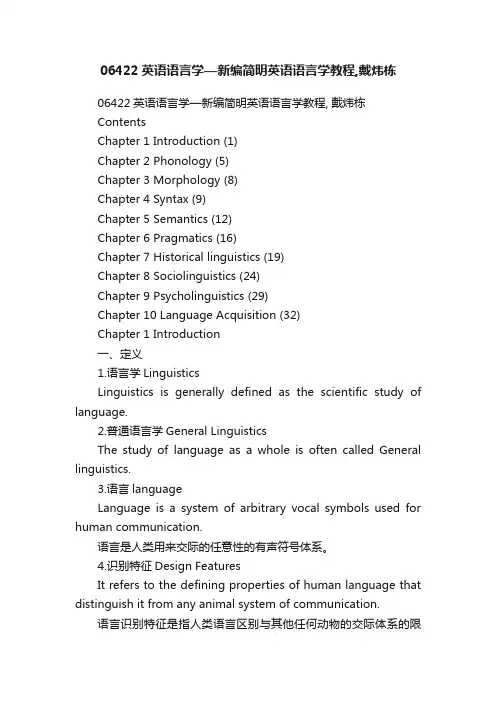
06422英语语言学—新编简明英语语言学教程,戴炜栋06422英语语言学—新编简明英语语言学教程, 戴炜栋ContentsChapter 1 Introduction (1)Chapter 2 Phonology (5)Chapter 3 Morphology (8)Chapter 4 Syntax (9)Chapter 5 Semantics (12)Chapter 6 Pragmatics (16)Chapter 7 Historical linguistics (19)Chapter 8 Sociolinguistics (24)Chapter 9 Psycholinguistics (29)Chapter 10 Language Acquisition (32)Chapter 1 Introduction一、定义1.语言学LinguisticsLinguistics is generally defined as the scientific study of language.2.普通语言学General LinguisticsThe study of language as a whole is often called General linguistics.3.语言languageLanguage is a system of arbitrary vocal symbols used for human communication.语言是人类用来交际的任意性的有声符号体系。
4.识别特征Design FeaturesIt refers to the defining properties of human language that distinguish it from any animal system of communication.语言识别特征是指人类语言区别与其他任何动物的交际体系的限定性特征。
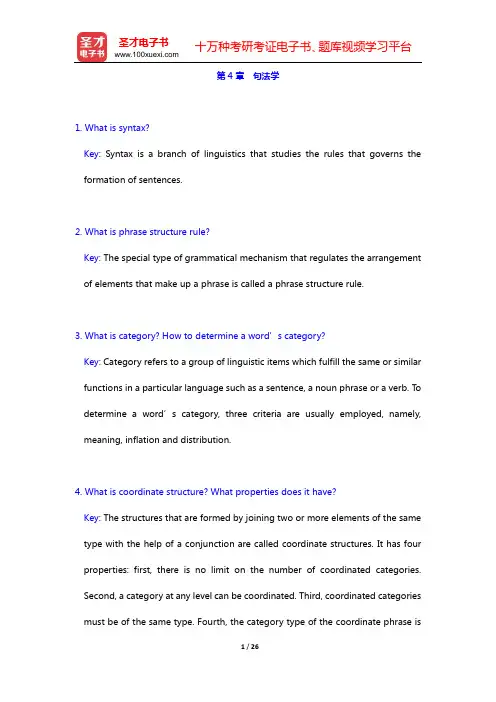
第4章句法学1. What is syntax?Key: Syntax is a branch of linguistics that studies the rules that governs the formation of sentences.2. What is phrase structure rule?Key: The special type of grammatical mechanism that regulates the arrangement of elements that make up a phrase is called a phrase structure rule.3. What is category? How to determine a word’s category?Key: Category refers to a group of linguistic items which fulfill the same or similar functions in a particular language such as a sentence, a noun phrase or a verb. T o determine a word’s category, three criteria are usually employed, namely, meaning, inflation and distribution.4. What is coordinate structure? What properties does it have?Key: The structures that are formed by joining two or more elements of the same type with the help of a conjunction are called coordinate structures. It has four properties: first, there is no limit on the number of coordinated categories. Second, a category at any level can be coordinated. Third, coordinated categories must be of the same type. Fourth, the category type of the coordinate phrase isidentical to the category type of the elements being conjoined.5. What elements does a phrase contain and what rule does each element play? Key: The phrase elements are specifiers, complements and modifiers. Specifiers help make more precise the meaning of the head. They typically mark a phrase. The complements provide information about entities and locations whose existence is implied by the meaning of the head. Modifiers specifies optionally expressible properties of heads.6. What is deep structure and what is surface structure?Key: The structure that formed by the XP rule in accordance with the head’s subcategorization properties is called the deep structure. The structure that corresponds to the final syntactic form of the sentence which results from appropriate transformation is called surface structure.7. Indicate the category of each word in the following sentences.a) The old lady got off the bus carefully.b) The car suddenly crashed onto the river bank.c) The blinding snowstorm might delay the opening of the school.d) This cloth feels quite soft.Key:8. The following phrases include a head, a complement, and a specifier. Draw the appropriate tree structure for each.a) rich in mineralsb) often read detective storiesc) an augment against the proposalsd) already above the windowKey: a) rich in mineralsb) often read detective storiesc) the argument against the proposalsd) already above the window9. The following sentences contain modifiers of various types. For each sentence, first identify the modifier(s), then draw the tree structures.a) A crippled passenger landed the airplane with extreme caution.b) A huge moon hung in the black sky.c) The man examined his car carefully yesterday.d) A wooden hut near the lake collapsed in the storm.Key: (The modifiers are represented by italics.)a) A crippled passenger landed the airplane with extreme caution.b) A huge moon hung in the black sky.c) The man examined his car carefully yesterday.d) A wooden hut near the lake collapsed in the storm.10. The following sentences all contain conjoined categories. Draw a tree structure for each of the sentences.a) Jim has washed the dirty shirts and pants.b) Helen put on her clothes and went out.c) Mary is fond of literature but tired of statistics.Key: a) Jim has washed the dirty shirts and pants.b) Helen put on her clothes and went out.c) Mary is fond of literature but tired of statistics.11. The following sentences all contain embedded clauses that function ascomplements of a verb, an adjective, a preposition or a noun. Draw a tree structure for each sentence.a) You know that I hate war.b) Gerry can’t believe the fact that Anna flunked the English exam.c) Chris was happy that his father bought him a Rolls-Royce.d) The children argued over whether bats had wings.Key: a) You know that I hate war.。
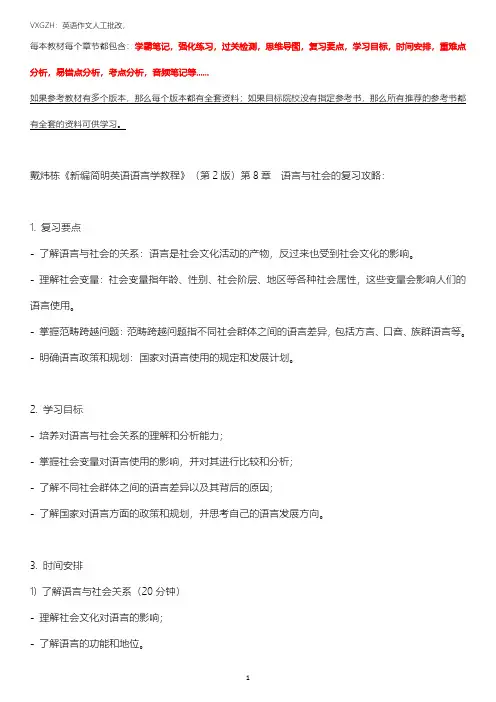
每本教材每个章节都包含:学霸笔记,强化练习,过关检测,思维导图,复习要点,学习目标,时间安排,重难点分析,易错点分析,考点分析,音频笔记等......如果参考教材有多个版本,那么每个版本都有全套资料;如果目标院校没有指定参考书,那么所有推荐的参考书都有全套的资料可供学习。
戴炜栋《新编简明英语语言学教程》(第2版)第8章语言与社会的复习攻略:1.复习要点-了解语言与社会的关系:语言是社会文化活动的产物,反过来也受到社会文化的影响。
-理解社会变量:社会变量指年龄、性别、社会阶层、地区等各种社会属性,这些变量会影响人们的语言使用。
-掌握范畴跨越问题:范畴跨越问题指不同社会群体之间的语言差异,包括方言、口音、族群语言等。
-明确语言政策和规划:国家对语言使用的规定和发展计划。
2.学习目标-培养对语言与社会关系的理解和分析能力;-掌握社会变量对语言使用的影响,并对其进行比较和分析;-了解不同社会群体之间的语言差异以及其背后的原因;-了解国家对语言方面的政策和规划,并思考自己的语言发展方向。
3.时间安排1)了解语言与社会关系(20分钟)-理解社会文化对语言的影响;-了解语言的功能和地位。
2)掌握社会变量(1小时)-掌握社会变量的概念;-分析社会变量对语言使用的影响;-通过实例加深对社会变量的理解。
3)范畴跨越问题(1小时)-探究方言、口音和族群语言等;-比较不同社会群体之间的语言差异;-分析范畴跨越问题背后的原因。
4)语言政策和规划(40分钟)-了解国家对语言方面的政策和规划;-思考自己的语言发展方向。
5)复习总结(20分钟)-回顾重点内容;-总结学习收获。
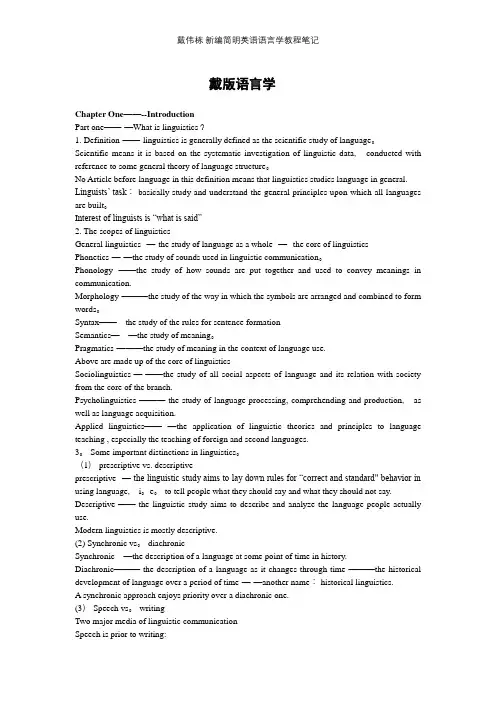
戴版语言学Chapter One——--IntroductionPart one——-—What is linguistics?1. Definition-——-linguistics is generally defined as the scientific study of language。
Scientific means it is based on the systematic investigation of linguistic data,conducted with reference to some general theory of language structure。
No Article before language in this definition means that linguistics studies language in general. Linguists’ task: basically study and understand the general principles upon which all languages are built。
I nterest of linguists is “what is said”2. The scopes of linguisticsGeneral linguistics--—-the study of language as a whole--—--the core of linguisticsPhonetics-—-—the study of sounds used in linguistic communication。
Phonology--——the study of how sounds are put together and used to convey meanings in communication.Morphology-———the study of the way in which the symbols are arranged and combined to form words。
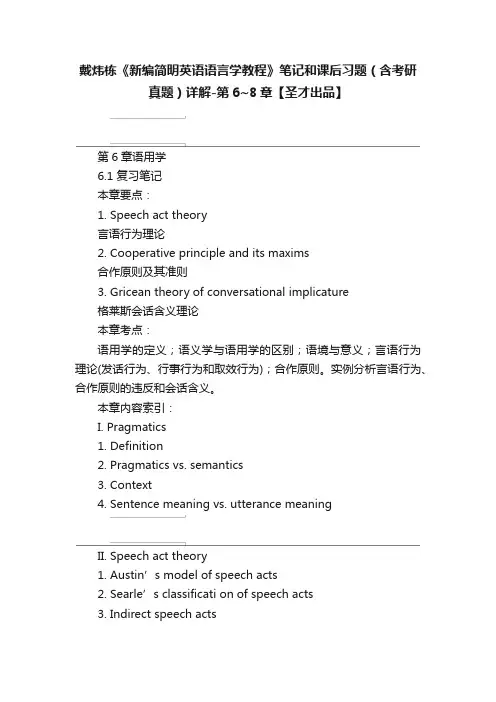
戴炜栋《新编简明英语语言学教程》笔记和课后习题(含考研真题)详解-第6~8章【圣才出品】第6章语用学6.1 复习笔记本章要点:1. Speech act theory言语行为理论2. Cooperative principle and its maxims合作原则及其准则3. Gricean theory of conversational implicature格莱斯会话含义理论本章考点:语用学的定义;语义学与语用学的区别;语境与意义;言语行为理论(发话行为、行事行为和取效行为);合作原则。
实例分析言语行为、合作原则的违反和会话含义。
本章内容索引:I. Pragmatics1. Definition2. Pragmatics vs. semantics3. Context4. Sentence meaning vs. utterance meaningII. Speech act theory1. Austin’s model of speech acts2. Searle’s classificati on of speech acts3. Indirect speech actsIII. Principle of conversation1. Cooperative Principle and its Maxims2. Violation of the MaximsIV. Conversational Implicature1. Definition2. Characteristics of Conversational Implicature(1) Calculability.(2) Cancellability(3) Non-detachability(4) Non-conventionality.V. Cross-cultural Pragmatic FailureI. Pragmatics(语用学)【考点:名词解释,与语义学的关系】1. Definition(定义)It is the study of how speakers of a language use sentences to effect successful communication.它是研究某一语言的言者是如何利用句子成功进行交际的。

•语言学家:1.F.de Saussure P4Swiss linguist. He distinct the langue and parole in the early 20 thcentury <course in general linguistics>写了《普通语言学》强调研究语言(what linguist should do is to abstract langue from parole)2.N ChomskAmerican linguist distinct competence and performance in the late1950s强调研究语言能力(competence)和索绪尔的相似点•Saussure 和chomsky 不同之处:索绪尔从社会学角度(sociological view)他的语言概念属于社会习俗范畴(social conventions);乔姆斯基是从心理学角度(Psychological view),认为语言能力是每个个体大脑的特征(property of mind of each individual)3.现代语言学基本上是描述性的(descriptive),传统语法是规定性的(prescriptive)4.现代语言学中共时性研究更重要(synchronic)Phonetics(语音学)Phonology (音位学)•发音器官1.pharyngeal cavity2.oral cavity3.nasal cavity•speech and writing are the two media or substances 言语和文字是自然语言的两种媒介和物质(言语比文字更加基础)•语音学从哪三个角度研究?(1)说话者角度articulatory phonetics发声语音学(历史最悠久)(2)听话者角度auditory phonetics听觉语音学(3)研究语音的传播方式acoustic phonetics声学语音学•主要现在用IPA标音标,但是语言学家会用严式标音(narrow transcription) 书上举了两个字母的例子{l} leap,feel ,health{p} pit,spit (送气,不送气)p h 来表送气•语音的分类:元音(voiced sound)和辅音•voiceless•元音的分类:(1)根据舌头哪一个部位最高,分为front、central、back(2)嘴巴的张合度,分为闭元音、半闭元音、半开元音、开元音(3)不圆唇的(所有前和中元音+{a:})和圆唇的(rounded)后元日•Segment 和syllable前面数有几个元音辅音;后面数有几个元音•语音学和音位学的区别(1)语音学家关注{l}的发音,清晰舌边音和模糊舌边音(2)音位学家关注{l}分布模式,即在什么位置发这个音如口}在元音后或辅音前,发模糊舌边音feel、quilt{l}放在元音前发清晰的舌边音leap注意:Phonology is concerned with the sound system of a particular language.(关注某种语言的语音系统)Linguistics is the scientific study of human languages in general.一、区分音素,音位,音位变体•音素:phone(1)在单词feel[fi:l],leaf[li:f],tar[tha:],star[sta:]中,一共有7个音素, 分别是[f],[i:],[T[l],[th].[t],[a:].(2)英语共有48个音素,其中元音20个,辅音28个。
戴炜栋《新编简明英语语言学教程》(第2版)笔记和课后习题(含考研真题)详解完整版>精研学习䋞>无偿试用20%资料
全国547所院校视频及题库全收集
考研全套>视频资料>课后答案>往年真题>职称考试
第1章导言
1.1复习笔记
1.2课后习题详解
1.3考研真题与典型题详解
第2章音位学
2.1复习笔记
2.2课后习题详解
2.3考研真题与典型题详解
第3章形态学
3.1复习笔记
3.2课后习题详解
3.3考研真题与典型题详解
第4章句法学
4.1复习笔记
4.2课后习题详解
4.3考研真题与典型题详解
第5章语义学
5.1复习笔记
5.2课后习题详解
5.3考研真题与典型题详解
第6章语用学
6.1复习笔记
6.2课后习题详解
6.3考研真题与典型题详解
第7章语言变化
7.1复习笔记
7.2课后习题详解
7.3考研真题与典型题详解
第8章语言与社会
8.1复习笔记
8.2课后习题详解
8.3考研真题与典型题详解
第9章语言与文化
9.1复习笔记
9.2课后习题详解
9.3考研真题与典型题详解第10章语言习得
10.1复习笔记
10.2课后习题详解
10.3考研真题与典型题详解第11章第二语言习得
11.1复习笔记
11.2课后习题详解
11.3考研真题与典型题详解第12章语言与大脑
12.1复习笔记
12.2课后习题详解
12.3考研真题与典型题详解。
新编简明英语语言学教程戴伟栋版第1章导言本章要点:1. The definition and main branches of linguistics study语言学的定义和研究范围2. Important distinction in Linguistic语言学的一些重要区分3. The definition and the design features of language语言的定义和识别特征4. Function of language语言的功能本章考点:语言学考点:语言学的定义,语言学中几组重要的区别,每组两个概念的含义、区分及其意义;普通语言学的主要分支及各自研究范畴;宏观语言及应用语言学的主要扥只及各自的研究范畴。
语言的考点:语言的定义;语言的识别特征(任意性,能产性,二重性,移位性,文化传递性);语言的功能1,The definition of linguistics语言的定义:Linguistics is generally defined as the scientific study of language(based on the systematic investigation of linguistic data, conducted with reference to general theory of language structure)2.The scope of linguistics语言学的范围A: micro-linguisticsPhonetics(语音学): the study of the sounds used in linguistic communication.Phonology(音系学): the study of how sounds put together and used to convey meaning in communication.(语音分布和排列的规则及音节的形式)Morphology(形态学): the study of the way in which the symbols are arranged and combined to form words.Syntax(句法学): the study of rules in the combination of words to form grammatically permissible sentences in language.Semantics(语义学): the study of meaning.Pragmatics(语用学): the study of the meaning in the context of language use.B: macro-linguisticsSociolinguistics: the study of all social aspects of language and its relation with the society form the core of the branch.Psycholinguistics: the study of language and its relation with psychology.Applied linguistics: the study of application of language to the solution of practical problems. Narrowly it is the application of linguistic theories and principles to language teaching, especially the teaching of foreign and second languages.3. Some important distinctions in linguistics 语言学中的重要区分A: Descriptive vs Prescriptive 描写式与规定式Descriptive: if a linguistic study aims to describe and analyze the language people actually use.Prescriptive: if the linguistic study aims to lay down rules for “correct and standard” behavior in using language, i.e. to tell people what should they say and what they should not say, it is said to be Prescriptive.B: Synchronic vs Diachronic 共时性和历时性Synchronic: the description of a language at some point of time in history is a synchronic study.Diachronic: the description of a language as it changes through time is a diachronic study.C: Speech vs writing 言语和文学These are major media of communication.D: Langue vs parole 语言与言语(Saussure 索緖尔)Langue: refers to the abstract linguistic system shared by the all the members of a speech community.Parole: refers to the realization of language in actual use.E: Competence vs performance 语言能力和语言应用(Chomsky乔姆斯基)Competence: refers to a user’s underlying knowledge about the system of the rules.Performance: refers to the actual use in concrete situations.乔姆斯基和索绪尔的区别:索绪尔采用的是社会学的观点,他的语言观念是社会惯例性的。
目 录第1章 导 言1.1 复习笔记1.2 课后习题详解1.3 考研真题与典型题详解第2章 音位学2.1 复习笔记2.2 课后习题详解2.3 考研真题与典型题详解第3章 形态学3.1 复习笔记3.2 课后习题详解3.3 考研真题与典型题详解第4章 句法学4.1 复习笔记4.2 课后习题详解4.3 考研真题与典型题详解第5章 语义学5.1 复习笔记5.2 课后习题详解5.3 考研真题与典型题详解第6章 语用学6.1 复习笔记6.2 课后习题详解6.3 考研真题与典型题详解第7章 语言变化7.1 复习笔记7.2 课后习题详解7.3 考研真题与典型题详解第8章 语言与社会8.1 复习笔记8.2 课后习题详解8.3 考研真题与典型题详解第9章 语言与文化9.1 复习笔记9.2 课后习题详解9.3 考研真题与典型题详解第10章 语言习得10.1 复习笔记10.2 课后习题详解10.3 考研真题与典型题详解第11章 第二语言习得11.1 复习笔记11.2 课后习题详解11.3 考研真题与典型题详解第12章 语言与大脑12.1 复习笔记12.2 课后习题详解12.3 考研真题与典型题详解第1章 导 言1.1 复习笔记本章要点:1. The definition and main branches of linguistics study语言学的定义和研究的范围2. Important distinctions in Linguistics语言学的一些重要区分3. The definition and the design features of language语言的定义与识别特征4. Functions of language语言的功能本章考点:1. 有关语言学的常考考点语言学的定义;语言学中几组重要区别,每组两个概念的含义、区分及其意义;普通语言学的主要分支学科及各自的研究范畴;宏观语言学及应用语言学的主要分支及各自的研究范畴。
●语言学家:1.F。
de Saussure P4Swiss linguist。
He distinct the langue and parole in theearly 20th century <course in general linguistics>写了《普通语言学》强调研究语言(what linguist should do isto abstract languefrom parole)2.N ChomskAmericanlinguist distinct competence and performancein the late 1950s强调研究语言能力(competence) 和索绪尔的相似点●Saussure和chomsky不同之处:索绪尔从社会学角度(sociologicalview)他的语言概念属于社会习俗范畴(socialconventions);乔姆斯基是从心理学角度(Psychological view),认为语言能力是每个个体大脑的特征(property of mind of eachindividual)3.现代语言学基本上是描述性的(descriptive),传统语法是规定性的(prescriptive)4.现代语言学中共时性研究更重要(synchronic)Phonetics(语音学) Phonology(音位学)●发音器官1.pharyngeal cavity2.oral cavity3.nasal cavity●speechandwriting are the twomedia orsubstances言语和文字是自然语言的两种媒介和物质(言语比文字更加基础)●语音学从哪三个角度研究?(1)说话者角度articulatory phonetics 发声语音学(历史最悠久)(2)听话者角度auditory phonetics 听觉语音学(3)研究语音的传播方式acoustic phonetics 声学语音学●主要现在用IPA标音标,但是语言学家会用严式标音(narrow transcription)书上举了两个字母的例子{l} leap,feel ,health{p}pit,spit (送气,不送气)p h来表送气●语音的分类:元音(voiced sound)和辅音●voiceless●元音的分类:(1)根据舌头哪一个部位最高,分为front、central、back(2)嘴巴的张合度,分为闭元音、半闭元音、半开元音、开元音(3)不圆唇的(所有前和中元音+{a:})和圆唇的(rounded)后元音●Segment 和syllable 前面数有几个元音辅音;后面数有几个元音●语音学和音位学的区别(1)语音学家关注{l} 的发音,清晰舌边音和模糊舌边音(2)音位学家关注{l}分布模式,即在什么位置发这个音如{l}在元音后或辅音前,发模糊舌边音feel、quilt{l}放在元音前发清晰的舌边音leap注意:Phonology is concernedwiththesoundsystem of aparticular language.(关注某种语言的语音系统) Linguistics is thescientific study ofhumanlanguagesingeneral。
第6章语用学6.1 复习笔记本章要点:1. Speech act theory言语行为理论2. Cooperative principle and its maxims合作原则及其准则3. Gricean theory of conversational implicature格莱斯会话含义理论本章考点:语用学的定义;语义学与语用学的区别;语境与意义;言语行为理论(发话行为、行事行为和取效行为);合作原则。
实例分析言语行为、合作原则的违反和会话含义。
本章内容索引:I. Pragmatics1. Definition2. Pragmatics vs. semantics3. Context4. Sentence meaning vs. utterance meaningII. Speech act theory1. Austin’s model of speech acts2. Searle’s classificati on of speech acts3. Indirect speech actsIII. Principle of conversation1. Cooperative Principle and its Maxims2. Violation of the MaximsIV. Conversational Implicature1. Definition2. Characteristics of Conversational Implicature(1) Calculability.(2) Cancellability(3) Non-detachability(4) Non-conventionality.V. Cross-cultural Pragmatic FailureI. Pragmatics(语用学)【考点:名词解释,与语义学的关系】1. Definition(定义)It is the study of how speakers of a language use sentences to effect successful communication.它是研究某一语言的言者是如何利用句子成功进行交际的。
2. Relation between pragmatics vs. semantics(语用学与语义学的关系)(1) Once the notion of context was taken into consideration, semantics spilled over into pragmatics.(2) What essentially distinguishes semantics and pragmatics is whether in the study of meaning the context of use is considered.(3) If it is not considered,the study is confined to the area of traditional semantics;if it is considered,the study is being carried out in the area of pragmatics.(1)一旦将语境的概念考虑在内,语义学就变成了语用学。
(2)语义学和语用学的本质区别在于在意义的研究中是否将运用的语境考虑在内。
(3)如果不加以考虑,那么研究就仅限于传统语义学的领域;如果考虑在内,那么研究就是在语用学的领域内进行的。
3. Context(语境)(1) Definition(定义)It is generally considered as constituted by the knowledge shared by the speaker and the hearer. Various components of shared knowledge have been identified, e. g. knowledge of the language. they use, knowledge of what has been said before, knowledge about the world in general, knowledge about the specific situation in which linguistic communication is taking place, and knowledge about each other.一般认为它是由言者和听者的共享知识构成的。
共享知识的各种成分已被确认,如他们所使用的语言知识,以前所说过的事物的知识,有关世界的总体的知识,有关语言交际产生的具体场景的知识和对彼此的了解。
(2) Significance(意义)Context determines the speaker’s use of language and also the hearer’s interpretation of what is said to him. Without such knowledge, linguistic communication would not be possible, and without considering such knowledge, linguistic communication cannot be satisfactorily accounted for in a pragmatic sense.语境决定着言者对语言的运用和听者对他所听到的话语的理解。
没有这种知识,语言交际就不可能。
而且不考虑这种知识,从语用含义的角度来看,语言交际就不可能得到满意的解释。
4. Sentence meaning vs. utterance meaning(句子意义与话语意义)While the meaning of a sentence is abstract and de-contextualized,that of an utterance is concrete and context dependent. The meaning of an utterance is based on sentence meaning: it is the realization of the abstract meaning of a sentence in a real situation of communication, or simply in a context.一个句子的意义是抽象的、非语境化的,而话语的意义却是具体的、依赖于语境的。
语话的意义是基于句子意义之上的;它是一个句子的抽象意义在一个真实的交际场合,或仅在一个语境中的体现。
II. Speech act theory(言语行为理论)【考点:名词解释,区分,举例】1. Austin’s model of speech acts(奥斯汀的言语行为模式)According to Austin’s model, a speaker might be performing three acts simultaneously when speaking: locutionary act, illocutionary act, and perlocutionary act.(1) A locutionary act is the act of uttering words, phrases, clauses. It is the act of conveying literal meaning by means of syntax, lexicon and phonology.(2) An illocutionary act is the act of expressing the speaker’s intention: it is the act performed in saying something.(3) A perlocutionary act is the act performed by or resulting from saying something; it is the consequence of, or the change brought about by the utterance; it is the act performed by saying something.根据奥斯汀的模式,言者可以在说话的时候同时执行三个动作:言内行为、言外行为和言后行为。
(1)言内行为就是发出词、短语、从句的动作。
它是通过句法、词汇和音位学的方式来传达字面意义的行为。
(2)言外行为是表达言者意图的行为,是在说话的过程中执行的动作。
(3)言后行为是由说某事或因为说某事而执行的动作;它是由话语所引起的后果或变化是由说某事而执行的动作。
2. Searle’s cla ssification of speech acts(舍尔对言语行为的分类)According to Searle, speech acts all into five general categories, i. e., there are five general types of things we do with language. Specific acts that fall into each type share the same illocutionary point, but differ in their strength.(1) Representatives: stating or describing, saying what the speaker believes tobe true. (The illocutionary point of the representatives is to commit the speaker to something’s being the case, to the truth of what has been said. Stating, believing, swearing, hypothesizing are among the most typical of the representatives. )E. g., (I swear) I have never seen the man before.(2) Directives: trying to get the hearer to do something. (Directives are attempts by the speaker to get the hearer to do something. Inviting, suggesting, requesting, advising, warning, threatening, ordering are all specific instances of this class. ) E. g. , Open the window!(3) Commissives: committing the speaker himself to some future course of action. ( Commissives are those illocutionary acts whose point is to commit the speaker to some future course of action, i. e. when speaking the speaker puts himself under a certain obligation. Promising, undertaking, vowing are the most typical cases. ) E. g. , I promise to come.(4) Expressives: expressing feelings or attitude towards an existing state. (The illocutionary point of expressives is to express the psycho—·logical state specified in the utterance. The speaker is expressing his feelings or attitude towards an existing state of affairs, e. g. apologizing, thanking, congratulating. ) E. g. , I am sorry for the mess I have made.(5) Declarations: bringing about immediate changes by saying something. (“D eclarations” has the characteristic that the successful performance of an act of this type brings about the correspondence between what is said and reality.) E. g. , I fire you!。